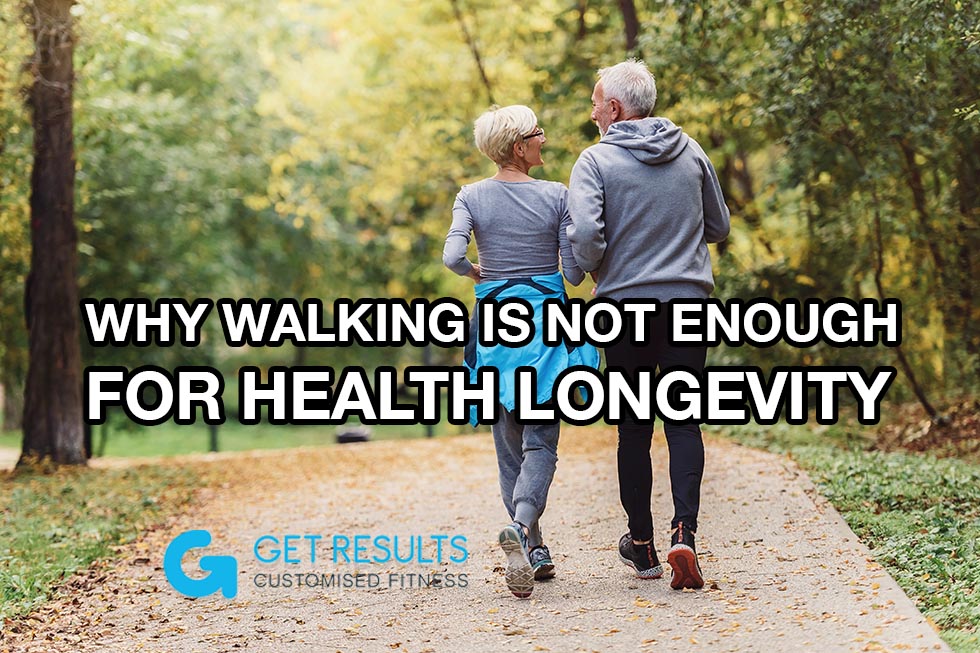Before I start this blog I want you to know I am a massive fan of walking and believe it is one of the best forms of exercise you can choose; it is free, enjoyable, most people are able to do it at some level, it does amazing things for both your cardiovascular health and mental health, and it can be a great way to catch up with friends.
The problem I see however for many over 50’s is that it is the only form of exercise that they do.
As we age the main health issues we encounter are loss of muscle; power;bone density; motor skills; flexibility/mobility. Walking will only have a small positive impact on these declines, however there are other more impactful behaviours you can adopt that will really slow down and in some cases halt these losses
Loss of Muscle
As we age we suffer from something called sarcopenia from the time you are born to around the time you turn 30, your muscles grow larger and stronger. But at some point in your 30s, you start to lose muscle mass and function. Physically inactive people can lose as much as 3% to 5% of their muscle mass each decade after age 30.
For many people the acceleration of sarcopenia can occur between their 60’s onwards. This will lead to increased risk for falling and a reduction in capabilities for many daily tasks.
Much of your focus therefore when it comes to exercise as we age should be focused on building and maintaining muscle mass through a well structured strength training program. No matter your age if you expose the body to some resistance training the only way it can respond is to adapt and change and build muscle, and this is where the magic happens.
Alongside the extra muscle you’re building you will be releasing lots of good hormones such as testosterone and growth hormone (two hormones that decline as we age) so resistance training can be a great way to improve vitality and keep you young.
Don’t worry when I say resistance training I don’t mean you will need to start off lifting super heavy weights. To begin with for most people your bodyweight and some resistance bands will be enough to get you going.
Loss of Power
I often describe the loss of power as being demonstrated when you see someone having to use the arms of their chair to get themselves from a seated position to standing. Basically they have lost the power required in their lower body to drive themselves up explosively.
We have two types of muscle fibres; slow twitch and fast twitch. Slow twitch are our postural/endurance muscle fibres that hold the body upright and are the main muscle fibres used when doing a lower intensity exercise such as walking or doing housework. Fast twitch fibres are used for more explosive movements and this is what declines fastest as we. So it is vitally important that you do exercises within your program that work on power (moving a mass at speed).
Bone Density
From about age 25 to age 50, bone density tends to stay stable with equal amounts of bone formation and bone breakdown. After age 50, bone breakdown (resorption) outpaces bone formation and bone loss often accelerates, particularly at the time of menopause. Bones then become more brittle and may break more easily. Osteoporosis affects around three million people in the UK.
Walking does improve bone density in the hip and femoral area (thigh bone) while its effects in other areas, including the spine, might be limited.
When it comes to strength training most people consider the positive impact it can have on muscles but tend to overlook the benefits it can have on bone. Numerous studies have shown that strength training can play a role in slowing bone loss, and several show it can even build bone. This is tremendously useful to help offset age-related declines in bone mass. Activities that put stress on bones can nudge bone-forming cells into action And with resistance training you can impact the bones in most areas of the body including the wrists which can often be an area that reduces in density as we age and can often be at risk of breaking or being painful.
Motor Skills
Again walking does have a small degree of impact on our motor skills, and if you walk on trails and uneven surfaces the challenge for our balance and stabilisers will increase. As we age a system in the body known as the proprioception system can start to lose its effectiveness:
Proprioception is one of our internal or hidden senses, it is our sense of body in space. There are receptors in our muscles and joints that send messages to our brains about where our body parts are in relation to each other and where our overall body is in relation to the world around us. Like everything else in the body this is a use it or lose it system.
It is important therefore that we challenge the proprioception system with some more demanding exercises such as single leg work, split kneeling work and dynamic movements that challenge balance. An improved proprioception system will reduce your risk of falling as your body will be better primed to respond to a loss of balance, a slip or a trip.
Those fast twitch muscle fibres that we discussed earlier will also be important when it comes to reducing our risks for falling as they are what should kick in to stop us from falling (alongside the response of the proprioception system).
Flexibility Mobility
The final part of fitness we wanted to discuss, that may be getting neglected if all you are doing is walking as your only form of exercise is mobility/flexibility.
Many of our clients when they start with us report that they feel stiff and less mobile than what they did when they were younger. But again the great news is by dedicating a little time to some stretching and mobility work you can gain back most of that mobility and flexibility you have lost. A body that is more mobile feels so much better to live with, you don’t have as many aches and pains and to be able to move more freely can be a real game changer for most people, allowing you to do more things and try more things.
We are big fans of piggybacking new habits onto existing habits, so for someone who regularly walks we recommend that they spend 10 minutes before their walks doing some dynamic mobilisers as a warm up then some stretching/mobilising after they finish their walk to loosen everything off.
Summary
So to summarise if you are a regular walker (or partake in any other type of cardiovascular exercise such as swimming or cycling) you are doing something that is truly great for your mind and your body, however I would strongly recommend that you go a little further do some of the exercise we have described above to truly maximise your capacity and greatly slow down the declines of ageing.
Paul
PS: If for some reason you are still not convinced to try and adopt some new exercise habits and still only want to walk as your mode of exercise, can I encourage you to try to incorporate some hills into your walks as this can help enhance your power and build some muscles for the lower body.
Products
Below are a list of products we recommend that will assist your training.
All of the products are used by us, so you can be sure they are of good quality.
If you buy using these links we will recieve a small commission at no extra cost to you. This is an easy way for you to help support our online platform.




